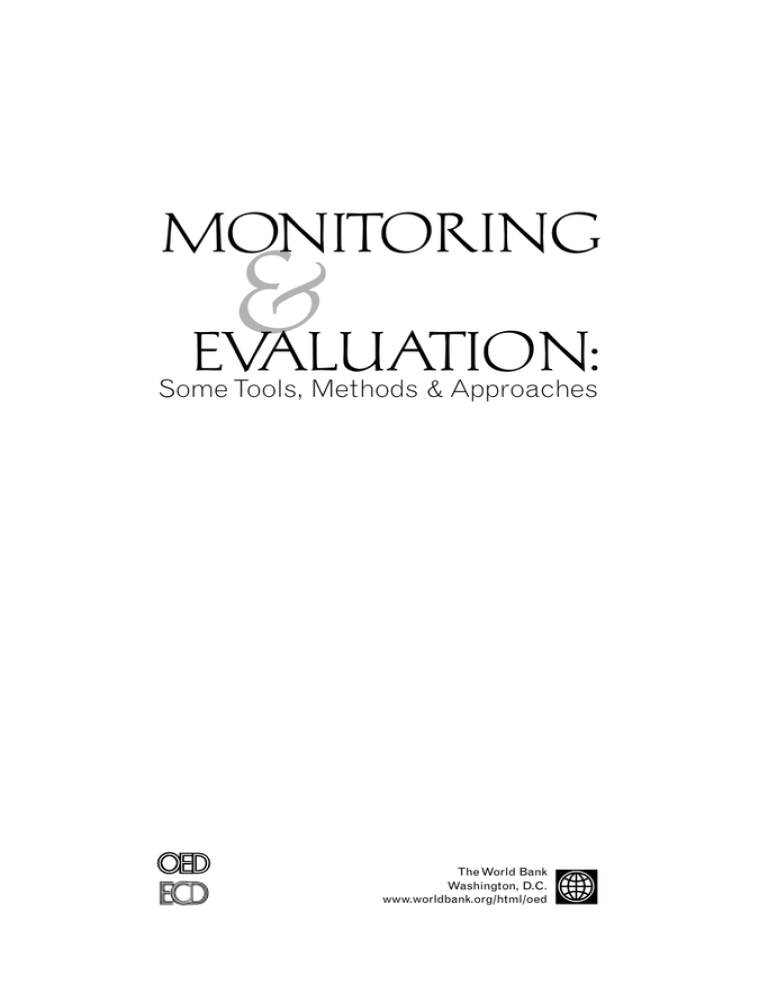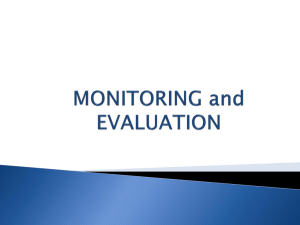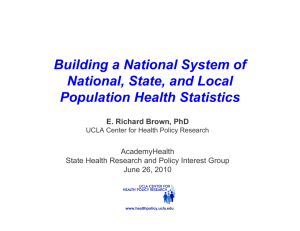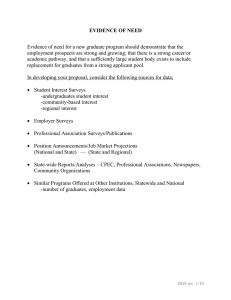
MONITORING
&
EVALUATION:
Some Tools, Methods & Approaches
The World Bank
Washington, D.C.
www.worldbank.org/html/oed
N
Copyright © 2002
The International Bank for Reconstruction
and Development/THE WORLD BANK
1818 H Street, N.W.
Washington, D.C. 20433, U.S.A.
All rights reserved.
Manufactured in the United States of America
The opinions expressed in this report do not necessarily represent the views of
the World Bank or its member governments. The World Bank does not guarantee the accuracy of the data included in this publication and accepts no
responsibility whatsoever for any consequence of their use. The boundaries,
colors, denominations, and any other information shown on any map in this
volume do not imply on the part of the World Bank Group any judgement on
the legal status of any territory or the endorsement or acceptance of such
boundaries.
W O R L D
B A N K
O P E R A T I O N S
E V A L U A T I O N
D E P A R T M E N T
E V A L U A T I O N
C A P A C I T Y
D E V E L O P M E N T
3
Table of Contents
M&E Overview . . . . . . . . . . . . . . . . . . . . . . . . . . . . . . . .5
Performance Indicators . . . . . . . . . . . . . . . . . . . . . . . . . . .6
The Logical Framework Approach . . . . . . . . . . . . . . . . . . .8
Theory-Based Evaluation . . . . . . . . . . . . . . . . . . . . . . . . .10
Formal Surveys . . . . . . . . . . . . . . . . . . . . . . . . . . . . . . . . .12
Rapid Appraisal Methods . . . . . . . . . . . . . . . . . . . . . . . . .14
Participatory Methods . . . . . . . . . . . . . . . . . . . . . . . . . . . .16
Public Expenditure Tracking Surveys . . . . . . . . . . . . . . . . .18
Impact Evaluation . . . . . . . . . . . . . . . . . . . . . . . . . . . . . . .20
Cost-Benefit and Cost-Effectiveness Analysis . . . . . . . . . . .22
Additional Resources on Monitoring and Evaluation . . . . .24
W O R L D
B A N K
O P E R A T I O N S
E V A L U A T I O N
D E P A R T M E N T
E V A L U A T I O N
C A P A C I T Y
D E V E L O P M E N T
5
M&E OVERVIEW:
SOME TOOLS, METHODS AND APPROACHES FOR
MONITORING AND EVALUATION
Monitoring and evaluation (M&E) of development activities provides government officials,
development managers, and civil society with better means for learning from
past experience, improving service delivery, planning and allocating resources,
and demonstrating results as part of accountability to key stakeholders.
Within the development community there is a strong focus on results—
this helps explain the growing interest in M&E. Yet there is often confusion
about what M&E entails. The purpose of this M&E Overview is to strengthen
awareness and interest in M&E, and to clarify what it entails.
You will find an overview of a sample of M&E tools, methods, and
approaches outlined here, including their purpose and use; advantages and
disadvantages; costs, skills, and time required; and key references. Those illustrated here include several data collection methods, analytical frameworks, and
types of evaluation and review. The M&E Overview discusses:
PURPOSE
◗
◗
◗
◗
◗
◗
◗
◗
◗
Performance indicators
The logical framework approach
Theory-based evaluation
Formal surveys
Rapid appraisal methods
Participatory methods
Public expenditure tracking surveys
Impact evaluation
Cost-benefit and cost-effectiveness analysis
This list is not comprehensive, nor is it intended to be. Some of these tools
and approaches are complementary; some are substitutes. Some have broad
applicability, while others are quite narrow in their uses. The choice of which
is appropriate for any given context will depend on a range of considerations.
These include the uses for which M&E is intended, the main stakeholders who
have an interest in the M&E findings, the speed with which the information is
needed, and the cost.
N
6
◗
Performance Indicators
What are they?
Performance indicators are measures of inputs, processes, outputs, outcomes, and
impacts for development projects, programs, or strategies. When supported with sound
data collection—perhaps involving formal surveys—analysis and reporting, indicators
enable managers to track progress, demonstrate results, and take corrective action to
improve service delivery. Participation of key stakeholders in defining indicators is
important because they are then more likely to understand and use indicators for
management decision-making.
What can we use them for?
■
■
■
Setting performance targets and assessing progress toward achieving them.
Identifying problems via an early warning system to allow corrective action
to be taken.
Indicating whether an in-depth evaluation or review is needed.
ADVANTAGES:
■ Effective means to measure progress toward objectives.
■ Facilitates benchmarking comparisons between different organizational units,
districts, and over time.
DISADVANTAGES:
■ Poorly defined indicators are not good measures of success.
■ Tendency to define too many indicators, or those without accessible data sources,
making system costly, impractical, and likely to be underutilized.
■ Often a trade-off between picking the optimal or desired indicators and having to
accept the indicators which can be measured using existing data.
COST:
Can range from low to high, depending on number of indicators collected, the frequency and quality of information sought, and the comprehensiveness of the system.
W O R L D
B A N K
O P E R A T I O N S
E V A L U A T I O N
D E P A R T M E N T
E V A L U A T I O N
C A P A C I T Y
D E V E L O P M E N T
7
SKILLS REQUIRED:
Several days of training are recommended to develop skills for defining practical
indicators. Data collection, analysis and reporting skills, and management information
system (MIS) skills are required to implement performance monitoring systems.
TIME REQUIRED:
Several days to several months, depending on extent of participatory process used to
define indicators and program complexity. Implementing performance monitoring
systems may take 6–12 months.
F O R
M O R E
I N F O R M A T I O N :
■
World Bank (2000). Key Performance Indicator Handbook. Washington, D.C.
■
Hatry, H. (1999). Performance Measurement: Getting Results. The Urban
Institute, Washington, D.C.
N
8
◗ The Logical Framework Approach
What is it?
The logical framework (LogFrame) helps to clarify objectives of any project, program,
or policy. It aids in the identification of the expected causal links—the “program
logic”—in the following results chain: inputs, processes, outputs (including coverage or
“reach” across beneficiary groups), outcomes, and impact. It leads to the identification
of performance indicators at each stage in this chain, as well as risks which might
impede the attainment of the objectives. The LogFrame is also a vehicle for engaging
partners in clarifying objectives and designing activities. During implementation the
LogFrame serves as a useful tool to review progress and take corrective action.
What can we use it for?
■
■
■
■
Improving quality of project and program designs—by requiring the specification of
clear objectives, the use of performance indicators, and assessment of risks.
Summarizing design of complex activities.
Assisting the preparation of detailed operational plans.
Providing objective basis for activity review, monitoring, and evaluation.
ADVANTAGES:
■ Ensures that decision-makers ask fundamental questions and analyze assumptions
and risks.
■ Engages stakeholders in the planning and monitoring process.
■ When used dynamically, it is an effective management tool to guide implementation, monitoring and evaluation.
DISADVANTAGES:
■ If managed rigidly, stifles creativity and innovation.
■ If not updated during implementation, it can be a static tool that does not reflect
changing conditions.
■ Training and follow-up are often required.
W O R L D
B A N K
O P E R A T I O N S
E V A L U A T I O N
D E P A R T M E N T
E V A L U A T I O N
C A P A C I T Y
D E V E L O P M E N T
9
COST:
Low to medium, depending on extent and depth of participatory process used to
support the approach.
SKILLS REQUIRED:
Minimum 3–5 days training for facilitators; additional facilitation skills required for
use in participatory planning and management.
TIME REQUIRED:
Several days to several months, depending on scope and depth of participatory process.
F O R
■
■
M O R E
I N F O R M A T I O N :
World Bank (2000). The Logical Framework Handbook, World Bank, http://www.world
bank.org/evaluation/logfram/
GTZ (1997). ZOPP: Objectives-Oriented Project Planning—available in several languages: http://www.gtz.de/pcm/download/english/zopp_e.pdf
N
10
◗ Theory-Based Evaluation
What is it?
Theory-based evaluation has similarities to the LogFrame approach but allows a much
more in-depth understanding of the workings of a program or activity—the “program
theory” or “program logic.” In particular, it need not assume simple linear cause-andeffect relationships. For example, the success of a government program to improve literacy levels by increasing the number of teachers might depend on a large number of factors. These include, among others, availability of classrooms and textbooks, the likely
reactions of parents, school principals and schoolchildren, the skills and morale of teachers, the districts in which the extra teachers are to be located, the reliability of government funding, and so on. By mapping out the determining or causal factors judged
important for success, and how they might interact, it can then be decided which steps
should be monitored as the program develops, to see how well they are in fact borne
out. This allows the critical success factors to be identified. And where the data show
these factors have not been achieved, a reasonable conclusion is that the program is less
likely to be successful in achieving its objectives.
What can we use it for?
■
■
Mapping design of complex activities.
Improving planning and management.
ADVANTAGES:
■ Provides early feedback about what is or is not working, and why.
■ Allows early correction of problems as soon as they emerge.
■ Assists identification of unintended side-effects of the program.
■ Helps in prioritizing which issues to investigate in greater depth, perhaps using
more focused data collection or more sophisticated M&E techniques.
■ Provides basis to assess the likely impacts of programs.
DISADVANTAGES:
■ Can easily become overly complex if the scale of activities is large or if an exhaustive
list of factors and assumptions is assembled.
■ Stakeholders might disagree about which determining factors they judge important,
which can be time-consuming to address.
W O R L D
B A N K
O P E R A T I O N S
E V A L U A T I O N
D E P A R T M E N T
E V A L U A T I O N
C A P A C I T Y
D E V E L O P M E N T
11
COST:
Medium—depends on the depth of analysis and especially the depth of data collection
undertaken to investigate the workings of the program.
SKILLS REQUIRED:
Minimum 3–5 days training for facilitators.
TIME REQUIRED:
Can vary greatly, depending on the depth of the analysis, the duration of the program
or activity, and the depth of the M&E work undertaken.
F O R
■
■
M O R E
I N F O R M A T I O N :
Weiss, Carol H. (1998). Evaluation. Prentice Hall, New Jersey, Second Edition.
Weiss, Carol H. (2000). “Theory-based evaluation: theories of change for poverty
reduction programs.” In O. Feinstein and R. Picciotto (eds.). Evaluation and Poverty
Reduction. Operations Evaluation Department, The World Bank, Washington, D.C.
N
12
◗ Formal Surveys
What are they?
Formal surveys can be used to collect standardized information from a carefully
selected sample of people or households. Surveys often collect comparable information
for a relatively large number of people in particular target groups.
What can we use them for?
■
■
■
■
■
■
■
Providing baseline data against which the performance of the strategy, program, or
project can be compared.
Comparing different groups at a given point in time.
Comparing changes over time in the same group.
Comparing actual conditions with the targets established in a program or project
design.
Describing conditions in a particular community or group.
Providing a key input to a formal evaluation of the impact of a program or project.
Assessing levels of poverty as basis for preparation of poverty reduction strategies.
ADVANTAGES:
■ Findings from the sample of people interviewed can be applied to the wider target
group or the population as a whole.
■ Quantitative estimates can be made for the size and distribution of impacts.
DISADVANTAGES:
■ With the exception of CWIQ, results are often not available for a long period of
time.
■ The processing and analysis of data can be a major bottleneck for the larger surveys
even where computers are available.
■ LSMS and household surveys are expensive and time-consuming.
■ Many kinds of information are difficult to obtain through formal interviews.
COST:
Ranges from roughly $30–60 per household for the CWIQ to $170 per household for
the LSMS. Costs will be significantly higher if there is no master sampling frame for
the country.
SKILLS REQUIRED:
Sound technical and analytical skills for sample and questionnaire design, data analysis,
and processing.
W O R L D
B A N K
O P E R A T I O N S
E V A L U A T I O N
D E P A R T M E N T
E V A L U A T I O N
C A P A C I T Y
D E V E L O P M E N T
13
TIME REQUIRED:
Depends on sample size. The CWIQ can be completed in 2 months. The LSMS
generally requires 18 months to 2 years.
Some Types of Survey
Multi-Topic Household Survey (also
known as Living Standards Measurement Survey—LSMS) is a multisubject integrated survey that provides a
means to gather data on a number of
aspects of living standards to inform policy. These surveys cover: spending, household composition, education, health,
employment, fertility, nutrition, savings,
agricultural activities, other sources of
income. Single-topic household surveys
cover a narrower range of issues in more
depth.
Core Welfare Indicators Questionnaire (CWIQ) is a household survey
that measures changes in social indicators for different population groups—
specifically indicators of access, utilization, and satisfaction with social and
economic services. It is a quick and
effective tool for improving activity
design, targeting services to the poor
F O R
■
■
■
■
■
M O R E
and, when repeated annually, for monitoring activity performance. Preliminary
results can be obtained within 30 days
of the CWIQ survey.
Client Satisfaction (or Service Delivery) Survey is used to assess the performance of government services based
on client experience. The surveys shed
light on the constraints clients face in
accessing public services, their views
about the quality and adequacy of services, and the responsiveness of government officials. These surveys are usually
conducted by a government ministry or
agency.
Citizen Report Cards have been conducted by NGOs and think-tanks in
several countries. Similar to service
delivery surveys, they have also investigated the extent of corruption
encountered by ordinary citizens. A
notable feature has been the widespread
publication of the findings.
I N F O R M A T I O N :
Sapsford, R. (1999). Survey Research. Sage, Newbury Park, CA.
Core Welfare Indicators Questionnaire: http://www4.worldbank.org/afr/stats/cwiq.cfm
LSMS: http://www.worldbank.org/htm/prdph/lsms
Client Satisfaction Surveys: http://www4.worldbank.org/afr/stats/wbi.cfm#sds
Citizen Report Cards: http://www.worldbank.org/participation/web/webfiles/
philipreport.htm
N
14
◗ Rapid Appraisal Methods
What are they?
Rapid appraisal methods are quick, low-cost ways to gather the views and feedback of
beneficiaries and other stakeholders, in order to respond to decision-makers’ needs for
information.
What can we use them for?
■
■
■
Providing rapid information for management decision-making, especially at the
project or program level.
Providing qualitative understanding of complex socioeconomic changes, highly
interactive social situations, or people’s values, motivations, and reactions.
Providing context and interpretation for quantitative data collected by more formal
methods.
ADVANTAGES:
■ Low cost.
■ Can be conducted quickly.
■ Provides flexibility to explore new ideas.
DISADVANTAGES:
■ Findings usually relate to specific communities or localities—thus difficult to
generalize from findings.
■ Less valid, reliable, and credible than formal surveys.
COST:
Low to medium, depending on the scale of methods adopted.
SKILLS REQUIRED:
Non-directive interviewing, group facilitation, field observation, note-taking, and basic
statistical skills.
TIME REQUIRED:
Four to six weeks, depending on the size and location of the population interviewed
and the number of sites observed.
W O R L D
B A N K
O P E R A T I O N S
E V A L U A T I O N
D E P A R T M E N T
E V A L U A T I O N
C A P A C I T Y
D E V E L O P M E N T
15
Rapid Appraisal Methods
Key informant interview—a series of
open-ended questions posed to individuals selected for their knowledge and
experience in a topic of interest. Interviews are qualitative, in-depth, and
semi-structured. They rely on interview
guides that list topics or questions.
Focus group discussion—a facilitated
discussion among 8–12 carefully
selected participants with similar backgrounds. Participants might be beneficiaries or program staff, for example.
The facilitator uses a discussion guide.
Note-takers record comments and
observations.
F O R
■
■
M O R E
Community group interview—a series
of questions and facilitated discussion
in a meeting open to all community
members. The interviewer follows a
carefully prepared questionnaire.
Direct observation—use of a detailed
observation form to record what is seen
and heard at a program site. The information may be about ongoing activities, processes, discussions, social interactions, and observable results.
Mini-survey—a structured questionnaire with a limited number of closeended questions that is administered to
50–75 people. Selection of respondents
may be random or ‘purposive’ (interviewing stakeholders at locations such
as a clinic for a health care survey).
I N F O R M A T I O N :
USAID. Performance Monitoring and Evaluation Tips, #s 2,4, 5,10.
http://www.usaid.gov/pubs/usaid_eval/#02
K. Kumar (1993). Rapid Appraisal Methods. The World Bank, Washington, D.C.
N
16
◗ Participatory Methods
What are they?
Participatory methods provide active involvement in decision-making for those with a
stake in a project, program, or strategy and generate a sense of ownership in the M&E
results and recommendations.
What can we use them for?
■
■
■
■
Learning about local conditions and local people’s perspectives and priorities to
design more responsive and sustainable interventions.
Identifying problems and trouble-shooting problems during implementation.
Evaluating a project, program, or policy.
Providing knowledge and skills to empower poor people.
ADVANTAGES:
■ Examines relevant issues by involving key players in the design process.
■ Establishes partnerships and local ownership of projects.
■ Enhances local learning, management capacity, and skills.
■ Provides timely, reliable information for management decision-making.
DISADVANTAGES:
■ Sometimes regarded as less objective.
■ Time-consuming if key stakeholders are involved in a meaningful way.
■ Potential for domination and misuse by some stakeholders to further their own
interests.
COST:
Low to medium. Costs vary greatly, depending on scope and depth of application and
on how local resource contributions are valued.
SKILLS REQUIRED:
Minimum several days’ training for facilitators.
W O R L D
B A N K
O P E R A T I O N S
E V A L U A T I O N
D E P A R T M E N T
E V A L U A T I O N
C A P A C I T Y
D E V E L O P M E N T
17
TIME REQUIRED:
Varies greatly, depending on scope and depth of application.
Commonly Used Participatory Tools
Stakeholder analysis is the starting
point of most participatory work and
social assessments. It is used to develop
an understanding of the power relationships, influence, and interests of the
various people involved in an activity
and to determine who should participate, and when.
Participatory rural appraisal is a
planning approach focused on sharing
learning between local people, both
urban and rural, and outsiders. It
enables development managers and
local people to assess and plan appropriate interventions collaboratively
F O R
■
■
M O R E
often using visual techniques so that
non-literate people can participate.
Beneficiary assessment involves systematic consultation with project beneficiaries and other stakeholders to identify and design development initiatives,
signal constraints to participation, and
provide feedback to improve services
and activities.
Participatory monitoring and evaluation involves stakeholders at different
levels working together to identify
problems, collect and analyze information, and generate recommendations.
I N F O R M A T I O N :
http://www.ids.ac.uk/ids/particip/research/pme.html
http://www.worldbank.org/participation/partme.htm
N
18
◗ Public Expenditure Tracking Surveys
What are they?
Public expenditure tracking surveys (PETS) track the flow of public funds and
determine the extent to which resources actually reach the target groups. The surveys
examine the manner, quantity, and timing of releases of resources to different levels
of government, particularly to the units responsible for the delivery of social services
such as health and education. PETS are often implemented as part of larger service
delivery and facility surveys which focus on the quality of service, characteristics of the
facilities, their management, incentive structures, etc.
What can we use them for?
■
■
Diagnosing problems in service delivery quantitatively.
Providing evidence on delays, “leakage,” and corruption.
ADVANTAGES:
■ Supports the pursuit of accountability when little financial information is available.
■ Improves management by pinpointing bureaucratic bottlenecks in the flow of funds
for service delivery.
DISADVANTAGES:
■ Government agencies may be reluctant to open their accounting books.
■ Cost is substantial.
COST:
Can be high until national capacities to conduct them have been established. For
example, the first PETS in Uganda cost $60,000 for the education sector and
$100,000 for the health sector.
W O R L D
B A N K
O P E R A T I O N S
E V A L U A T I O N
D E P A R T M E N T
E V A L U A T I O N
C A P A C I T Y
D E V E L O P M E N T
19
SKILLS REQUIRED:
Sound technical and analytical skills for sample and questionnaire design, data analysis
and processing, and good understanding of sector to be assessed.
TIME REQUIRED:
Five to six months (survey alone takes 1–2 months).
F O R
■
M O R E
I N F O R M A T I O N :
http://www.worldbank.org/research/projects/publicspending/tools/tools.htm
N
20
◗ Impact Evaluation
What is it?
Impact evaluation is the systematic identification of the effects—positive or negative,
intended or not—on individuals, households, institutions, and the environment caused
by a given development activity such as a program or project. Impact evaluation helps
us to better understand the extent to which activities reach the poor and the magnitude
of their effects on people’s welfare.
What can we use it for?
■
■
■
■
■
■
Measuring outcomes and impacts of an activity and distinguishing these from the
influence of other, external factors.
Helping to clarify whether costs for an activity are justified.
Informing decisions on whether to expand, modify, or eliminate projects, programs,
or policies.
Drawing lessons for improving the design and management of future activities.
Comparing effectiveness of alternative interventions.
Strengthening accountability for results.
ADVANTAGES:
■ Provides estimates of the magnitude of outcomes and impacts for different
demographic groups, regions, or over time.
■ Provides answers to some of the most central development questions—to what
extent are we making a difference? What are the results on the ground? How can
we do it better?
■ Systematic analysis and rigor can give managers and policy-makers added
confidence in decision-making.
DISADVANTAGES:
■ Expensive and time-consuming.
■ Reduced utility when decision-makers need information quickly.
■ Difficulties in identifying an appropriate counter-factual.
W O R L D
B A N K
O P E R A T I O N S
E V A L U A T I O N
D E P A R T M E N T
E V A L U A T I O N
C A P A C I T Y
D E V E L O P M E N T
21
COST:
High. A number of World Bank impact evaluations have ranged from $200,000–
$900,000, depending on program size, complexity, and data collection requirements.
SKILLS REQUIRED:
Strong technical skills in social science research design, management, analysis, and
reporting. Ideally, a balance of quantitative and qualitative research skills on the part of
the evaluation team.
TIME REQUIRED:
Can take up to 2 years or more.
F O R
M O R E
I N F O R M A T I O N :
For more information:
■ Baker, J. (2000). Evaluating the Poverty Impact of Projects: A Handbook for Practitioners.
The World Bank, Washington, D.C.
http://www.worldbank.org/poverty/library/impact.htm
■ http://www.worldbank.org/poverty/impact/index.htm
■ Roche, C. (1999). Impact Assessment for Development Agencies: Learning to Value
Change. Oxfam, Oxford.
N
22
◗ Cost-Benefit and Cost-Effectiveness
Analysis
What are they?
Cost-benefit and cost-effectiveness analysis are tools for assessing whether or not the
costs of an activity can be justified by the outcomes and impacts. Cost-benefit analysis
measures both inputs and outputs in monetary terms. Cost-effectiveness analysis estimates inputs in monetary terms and outcomes in non-monetary quantitative terms
(such as improvements in student reading scores).
What can we use them for?
■
■
Informing decisions about the most efficient allocation of resources.
Identifying projects that offer the highest rate of return on investment.
ADVANTAGES:
■ Good quality approach for estimating the efficiency of programs and projects.
■ Makes explicit the economic assumptions that might otherwise remain implicit or
overlooked at the design stage.
■ Useful for convincing policy-makers and funders that the benefits justify the activity.
DISADVANTAGES:
■ Fairly technical, requiring adequate financial and human resources available.
■ Requisite data for cost-benefit calculations may not be available, and projected
results may be highly dependent on assumptions made.
■ Results must be interpreted with care, particularly in projects where benefits are
difficult to quantify.
COST:
Varies greatly, depending on scope of analysis and availability of data.
W O R L D
B A N K
O P E R A T I O N S
E V A L U A T I O N
D E P A R T M E N T
E V A L U A T I O N
C A P A C I T Y
D E V E L O P M E N T
23
SKILLS REQUIRED:
The procedures used in both types of analyses are often highly technical. They require
skill in economic analysis and availability of relevant economic and cost data.
TIME REQUIRED:
Varies greatly depending on scope of analysis and availability of data.
F O R
■
M O R E
I N F O R M A T I O N :
Belli, P. et al. (2000). Economic Analysis of Investment Operations: Analytical Tools and
Practical Applications. The World Bank, Washington, D.C.
GOOD PRACTICE EXAMPLES OF COST-BENEFIT ANALYSIS:
■ http://kms.worldbank.org/edunet/TEN_DIMENSIONS/DIM_4/cb_ce.htm
Additional Resources on
Monitoring and Evaluation
World Wide Web sites
■
World Bank Evaluation, Monitoring and Quality
Enhancement: http://www.worldbank.org/evaluation/
■
Monitoring & Evaluation Capacity Development:
http://www.worldbank.org/evaluation/me/
■
Monitoring and Evaluation News:
http://www.mande.co.uk/news.htm
■
USAID Center for Development Information and
Evaluation: http://www.usaid.gov/pubs/usaid_eval/





